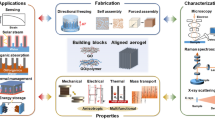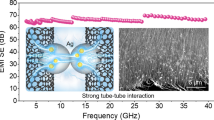Abstract
Silver nanowires (AgNWs) are promising materials in the fabrication of flexible and transparent conductive thin films (FTCFs), which are key components of flexible optoelectronic devices. However, the performance of AgNW FTCFs is severely limited by their low aspect ratio, and the fabrication of AgNWs with a high aspect ratio remains a significant challenge. In this study, AgNWs with a diameter of 40 nm and aspect ratio of 2000 were synthesized rapidly by controlling the total molar concentration of Cl− ions in the reaction solution by a typical polyol method to adjust the Cu2+/Fe3+ molar ratio. Subsequently, AgNW FTCFs were fabricated by the coating method using hydroxyethyl cellulose (HEC). The films exhibited a low sheet resistance of 68 Ω/sq and transmittance of 86.70%, which are comparable to those of typical indium tin oxide electrodes. Meanwhile, a mechanical robustness test showed that the sheet resistance of the AgNW-HEC films increased by only 3.15% even after 3000 bending cycles.





Similar content being viewed by others
Data availability
Data and materials will be made available on request.
Code availability
Not applicable.
References
L. Lin, Y. Choi, T. Chen, H. Kim, K.S. Lee, J.M. Kang, L. Lyu, J.F. Gao, Y. Piao, Superhydrophobic and wearable TPU based nanofiber strain sensor with outstanding sensitivity for high-quality body motion monitoring. Chem. Eng. J. 419, 129513 (2021)
A.R. Madaria, A. Kumar, C. Zhou, Large scale, highly conductive and patterned transparent films of silver nanowires on arbitrary substrates and their application in touch screens. Nanotechnology 22, 245201 (2011)
A. Moradi, M. Abrari, M. Ahmadi, Efficiency enhancement in dye-sensitized solar cells through the decoration of electro-spun TiO(2)nanofibers with ag nanoparticles. J. Mater. Sci. Mater. Electron. 31, 16759–16768 (2020)
Z.-R. Zhu, W. Geng, Q. Zhu, A.S. Ethiraj, T. Wang, L.-C. Jing, Y.-J. Ning, Y. Tian, W.-H. Geng, L. Wu, H.-Z. Geng, Highly transparent, low sheet resistance and stable tannic acid modified-SWCNT/AgNW double-layer conductive network for organic light emitting diodes. Nanotechnology 32, 015708 (2021)
H. Lee, D. Lee, Y. Ahn, E.-W. Lee, L.S. Park, Y. Lee, Highly efficient and low voltage silver nanowire-based OLEDs employing a n-type hole injection layer. Nanoscale 6, 8565–8570 (2014)
W. Dong, C. Zhu, W. Hu, L. Xiao, Y. Huang, Stretchable human-machine interface based on skin-conformal sEMG electrodes with self-similar geometry. J. Semicond. 39, 014001–014001 (2018)
M. Saychak, N. Borodinov, R. Burtovyy, M. Anayee, K. Hu, R. Ma, A. Grant, H. Li, D.B. Cutshall, Y. Wen, G. Koley, W.R. Harrell, G. Chumanov, V. Tsukruk, I. Luzinov, Highly conductive and transparent reduced graphene oxide nanoscale films via thermal conversion of polymer-encapsulated graphene oxide sheets. ACS Appl. Mater. Interfaces 10, 3975–3985 (2018)
D.H. Shin, S.W. Seo, J.M. Kim, H.S. Lee, S.-H. Choi, Graphene transparent conductive electrodes doped with graphene quantum dots-mixed silver nanowires for highly-flexible organic solar cells. J. Alloys Compd. 744, 1–6 (2018)
Y. Chen, X.-Y. Fu, Y.-Y. Yue, N. Zhang, J. Feng, H.-B. Sun, Flexible and transparent supercapacitor based on ultrathin Au/graphene composite electrodes. Appl. Surf. Sci. 467, 104–111 (2019)
J. Ning, L. Hao, M. Jin, X. Qiu, Y. Shen, J. Liang, X. Zhang, B. Wang, X. Li, L. Zhi, A facile reduction method for roll-to-roll production of high performance graphene-based transparent conductive films. Adv. Mater. 29, 1605028 (2017)
A.A. Tonkikh, V.I. Tsebro, E.A. Obraztsova, D.V. Rybkovskiy, A.S. Orekhov, I.I. Kondrashov, E.I. Kauppinen, A.L. Chuvilin, E.D. Obraztsova, Films of filled single-wall carbon nanotubes as a new material for high-performance air-sustainable transparent conductive electrodes operating in a wide spectral range. Nanoscale 11, 6755–6765 (2019)
O. Urper, I. Cakmak, N. Karatepe, Fabrication of carbon nanotube transparent conductive films by vacuum filtration method. Mater. Lett. 223, 210–214 (2018)
P. Zhao, Q. Tang, X. Zhao, Y. Tong, Y. Liu, Highly stable and flexible transparent conductive polymer electrode patterns for large-scale organic transistors. J. Colloid Interface Sci. 520, 58–63 (2018)
J. Yang, C.X. Bao, K. Zhu, T. Yu, Q.Y. Xu, High-performance transparent conducting metal network electrodes for perovksite photodetectors. ACS Appl. Mater. Interfaces 10, 1996–2003 (2018)
X.S. Li, Y.M. Wang, C.R. Yin, Z.X. Yin, Copper nanowires in recent electronic applications: progress and perspectives. J. Mater. Chem. C 8, 849–872 (2020)
Y. Li, Y. Li, Z. Fan, H. Yang, X. Yuan, C. Wang, Ascorbic acid-assisted one-step chemical reaction to design an ultralong silver nanowire structure for a highly transparent flexible conducting Film. ACS Omega 5, 18458–18464 (2020)
J. Lee, P. Lee, H.B. Lee, S. Hong, I. Lee, J. Yeo, S.S. Lee, T.S. Kim, D. Lee, S.H. Ko, Room-temperature nanosoldering of a very long metal nanowire network by conducting-polymer-assisted joining for a flexible touch-panel application. Adv. Funct. Mater. 23, 4171–4176 (2013)
R.M. Mutiso, M.C. Sherrott, A.R. Rathmell, B.J. Wiley, K.I. Winey, Integrating simulations and experiments to predict sheet resistance and optical transmittance in nanowire films for transparent conductors. ACS Nano 7, 7654–7663 (2013)
R.R. da Silva, M. Yang, S.-I. Choi, M. Chi, M. Luo, C. Zhang, Z.-Y. Li, P.H.C. Camargo, S.J. Lima Ribeiro, Y. Xia, Facile synthesis of Sub-20 nm silver nanowires through a bromide-mediated polyol method. ACS Nano 10, 7892–7900 (2016)
Z. Chen, J.W. Chang, C. Balasanthiran, S.T. Milner, R.M. Rioux, Anisotropic growth of silver nanoparticles is kinetically controlled by polyvinylpyrrolidone binding. J. Am. Chem Soc 141, 4328–4337 (2019)
Y.G. Sun, Y.D. Yin, B.T. Mayers, T. Herricks, Y.N. Xia, Uniform silver nanowires synthesis by reducing AgNO3 with ethylene glycol in the presence of seeds and poly(vinyl pyrrolidone). Chem. Mater. 14, 4736–4745 (2002)
M. Jia-qing, H. Jun-wei, Template-directed synthesis of Ag nanowire arrays by a simple paired cell method for SERS. Optoelectron. Lett. 11, 401–404 (2015)
X.J. Xu, G.T. Fei, X.W. Wang, Z. Jin, W.H. Yu, L.D. Zhang, Synthetic control of large-area, ordered silver nanowires with different diameters. Mater. Lett. 61, 19–22 (2007)
L. Lin, L. Liu, P. Peng, G. Zou, W.W. Duley, Y.N. Zhou, In situ nanojoining of Y- and T-shaped silver nanowires structures using femtosecond laser radiation. Nanotechnology 27, 125201 (2016)
Y. Chen, Y. Zhang, J. Chen, X. Sun, Understanding the influence of crystallographic structure on controlling the shape of noble metal nanostructures. Cryst. Growth Des. 11, 5457–5460 (2011)
W.C. Zhang, X.L. Wu, H.T. Chen, Y.J. Gao, J. Zhu, G.S. Huang, P.K. Chu, Self-organized formation of silver nanowires, nanocubes and bipyramids via a solvothermal method. Acta Mater. 56, 2508–2513 (2008)
Y.G. Sun, B. Mayers, T. Herricks, Y.N. Xia, Polyol synthesis of uniform silver nanowires: a plausible growth mechanism and the supporting evidence. Nano Lett. 3, 955–960 (2003)
X.-M. Wang, L. Chen, E. Sowade, R.D. Rodriguez, E. Sheremet, C.-M. Yu, R.R. Baumann, J.-J. Chen, Ultra-uniform and very thin Ag nanowires synthesized via the synergy of Cl–, Br– and Fe3+ for transparent conductive films. Nanomaterials 10, 237 (2020)
J.-J. Chen, S.-L. Liu, H.-B. Wu, E. Sowade, R.R. Baumann, Y. Wang, F.-Q. Gu, C.-R.-L. Liu, Z.-S. Feng, Structural regulation of silver nanowires and their application in flexible electronic thin films. Mater. Des. 154, 266–274 (2018)
K. Zhan, R. Su, S. Bai, Z. Yu, N. Cheng, C. Wang, S. Xu, W. Liu, S. Guo, X.-Z. Zhao, One-pot stirring-free synthesis of silver nanowires with tunable lengths and diameters via a Fe3+ & Cl– co-mediated polyol method and their application as transparent conductive films. Nanoscale 8, 18121–18133 (2016)
N. Xiao, Y. Chen, W. Weng, X. Chi, H. Chen, D. Tang, S. Zhong, Mechanism understanding for size regulation of silver nanowires mediated by halogen ions. Nanomaterials 12, 2681 (2022)
Y. Mao, H. Yang, C. Hu, J. Guo, X. Meng, Y. Yang, Large-scale synthesis of AgNWs with ultra-high aspect ratio above 4000 and their application in conductive thin film. J. Mater. Sci. Mater. Electron. 28, 5308–5314 (2017)
C. Liu, X. Zhang, J. Shan, Z. Li, X. Guo, X. Zhao, H. Yang, Large-scale preparation of silver nanowire-based flexible transparent film heaters by slot-die coating. Materials 15, 2634 (2022)
Acknowledgements
This work is supported by the Science and Technology Project of Jiaxing (2022AY10005); Science and Technology Project of Jiaxing (2019AY11018); General scientific research project of Zhejiang Education Department (Y202250333).
Funding
This research is funded by the Science and Technology Project of Jiaxing (2022AY10005); Science and Technology Project of Jiaxing (2019AY11018); General scientific research project of Zhejiang Education Department (Y202250333).
Author information
Authors and Affiliations
Contributions
HZA: investigation, data curation, writing-original draft preparation, writing-review and editing, formal analysis. JYF: conceptualization, investigation, methodology, validation, data curation, writing-review and editing, resources, supervision, project administration. PC: investigation, data curation, formal analysis. TY: investigation, data curation, formal analysis. TS: formal analysis. BX: review and editing, formal analysis, funding acquisition.
Corresponding authors
Ethics declarations
Conflict of interest
No potential conflict of interest was reported by the authors.
Ethical approval
Not applicable.
Consent to participate
Not applicable.
Consent for publication
Informed consent.
Additional information
Publisher’s Note
Springer Nature remains neutral with regard to jurisdictional claims in published maps and institutional affiliations.
Supplementary Information
Below is the link to the electronic supplementary material.
Rights and permissions
Springer Nature or its licensor (e.g. a society or other partner) holds exclusive rights to this article under a publishing agreement with the author(s) or other rightsholder(s); author self-archiving of the accepted manuscript version of this article is solely governed by the terms of such publishing agreement and applicable law.
About this article
Cite this article
Ao, H., Feng, J., Cao, P. et al. Synthesis of Ag nanowires with an aspect ratio higher than 2000 for the fabrication of transparent conductive film. J Mater Sci: Mater Electron 34, 2183 (2023). https://doi.org/10.1007/s10854-023-11579-0
Received:
Accepted:
Published:
DOI: https://doi.org/10.1007/s10854-023-11579-0




